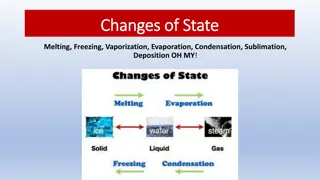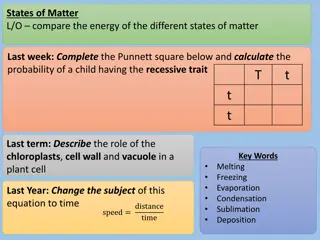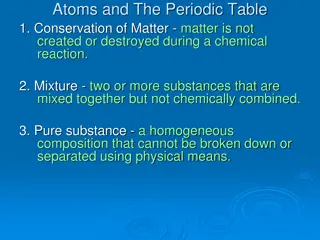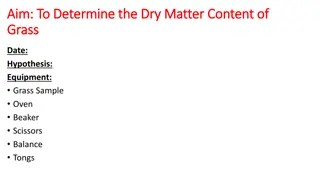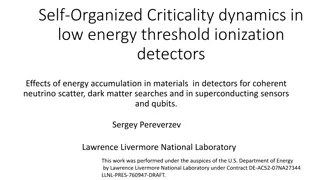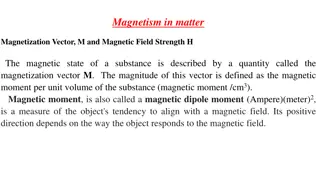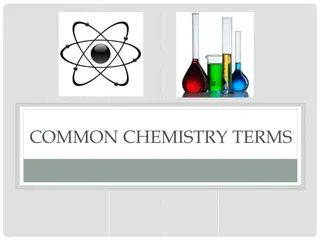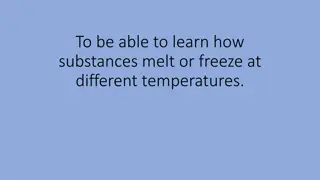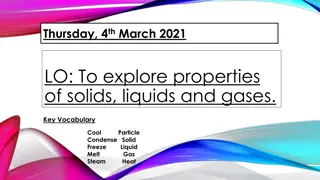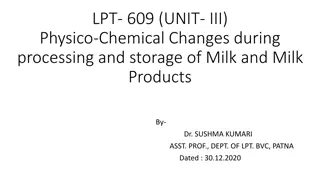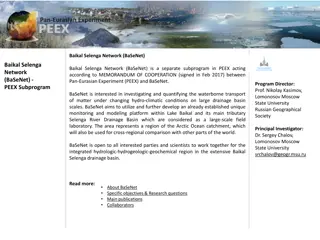Understanding Changes of State in Matter
Explore the three states of matter, the law of conservation of mass, and what happens to particles in an ice cube when placed in warm water. Discover the importance of melting point, boiling point, and how impurities affect these points. Dive into temperature-time graphs to identify melting and boiling points, as well as self-assessment tasks to reinforce learning.
Download Presentation

Please find below an Image/Link to download the presentation.
The content on the website is provided AS IS for your information and personal use only. It may not be sold, licensed, or shared on other websites without obtaining consent from the author. Download presentation by click this link. If you encounter any issues during the download, it is possible that the publisher has removed the file from their server.
E N D
Presentation Transcript
Changes of State Do now activity: 1. What are three states of matter? 2. What is the law of the conservation of mass? 3. Explain what happens to the particles found within an ice cube when the ice cube is placed in a mug of warm water.
Progress indicators GradeObjective Learning Outcome 1-3 Explain what is meant by the terms: melting point, boiling point and explain the difference between boiling and evaporation Define the difference between melting points and boiling points Explain the difference between boiling and evaporation 4-6 7-9 To be able interpret and use a temperature- time graph to find the melting point and boiling point of a substance.
For any substance undergoing a change of state, it s temperature stays the same whilst the change of state is taking place. The temperature at which a solid changes to a liquid is called the .. Melting point The temperature at which a liquid turns to a gas is called the Boiling point The temperature at which a liquid changes to a solid is called its Freezing point Which two temperatures will always be the same?
Why do you think salt is added to a pan of water you want to boil? Or salt is added to roads or paths to stop them from freezing over? Impurities in a substance can affect the melting point and boiling point of that substance, for example the melting point of water is lowered if you add salt to the water.
Stays constant at 0 C until all the ice has melted Increases until it reaches 0 C when the ice starts to melt at 0 C Increases from 0 C to 100 C until the water in the beaker starts to boil at 100 C Stays constant at 100 C as the water turn to steam Task: There are four points labelled on the graph opposite, sketch the graph in your books and order the statements above to match the numbers. 4. Water boils 100 Temperature( C) 3. Water heats up 2. Ice melts 0 1. Ice warms Time
Self-assessment: 4. Stays constant at 100 C as the water turn to steam 3. Increases from 0 C to 100 C until the water in the beaker starts to boil at 100 C 2. Stays constant at 0 C until all the ice has melted 1. Increases until it reaches 0 C when the ice starts to melt at 0 C
Energy transfers during changes of state Liquid The temperature stops rising at the solids melting point. It remains constant until the solid has completely melted. Discuss in pairs why you think this might happen? Temperature/ C Solid melts Solid time At its melting point, enough energy is being transferred from the surroundings to the solid. This energy is used to break the forces between the particles of the solid, this enables the particles to break away from their fixed position, thus starting the melting process. Once all the particles are free to move the solid has completely melted, the transfer of energy from the surroundings now causes the temperature of the liquid to rise
The energy transferred to a substance when it changes its state is called latent heat. The energy transferred to the substance to melt or boil it is hidden by the substance because its temperature does not change at the substances melting or boiling point
Task: A pure solid substance X was heated in a tube and its temperature was measured every 30 seconds. The measurements are given in the table below: 1 30 60 90 120 150 180 210 240 270 300 Time (seconds) 20 35 49 61 71 79 79 79 79 86 92 Temperature in C a) Use the measurements in the table to plot a graph of temperature (y-axis) against time (x-axis) b) Use your graph to find the melting point of X c) Describe the physical state of the substance as it was heated from 60 C to 90 C Extension: A substance has a melting point of 75 C. Describe how the arrangement and motion of the particles changes as the substance cools from 80 C to 70 C
Self-assessment: a) b) c) Melting point - 79 C As the substance is heated from 60 C to 79 C the particles in the solid state start to vibrate about their fixed positions. At 79 C the substance has gained enough energy to start melting from a solid to a liquid state. For 90s the substance stays the same temperature (79 C) as it melts, the energy transferred to the substance during this period is called latent heat. At 240s the substance is now in a liquid state and its temperature begins to rise.
Exam-style Question Task: Use your knowledge of what you have learned this lesson to complete the exam-style question.
Mark Scheme: AB Changing state from a solid to a liquid / melting 1 At a steady temperature 1 BC Temperature of liquid rises 1 Until it reaches boiling point 1
Plenary ~ Pick a task: Write a definition for the following key words: Summarise what you have learnt today in 3 sentences a) Vaporisation b) Density c) Freezing d) Latent heat e) Melting point




